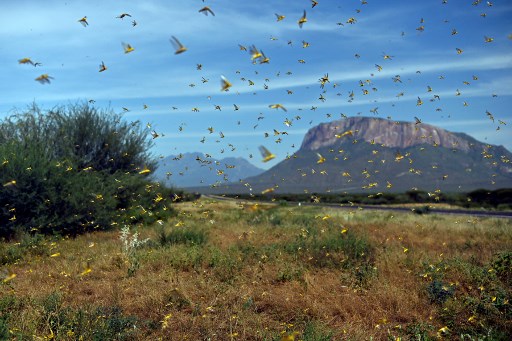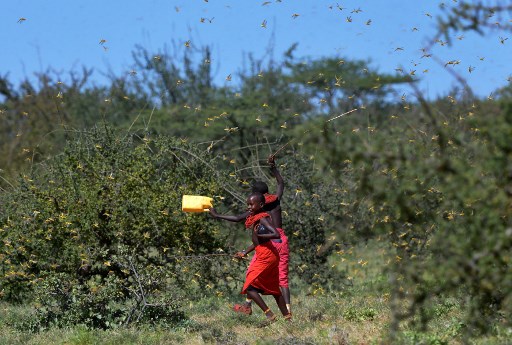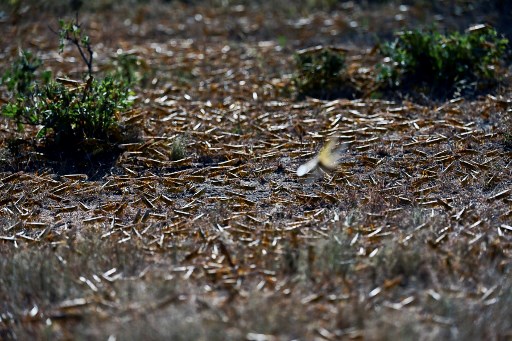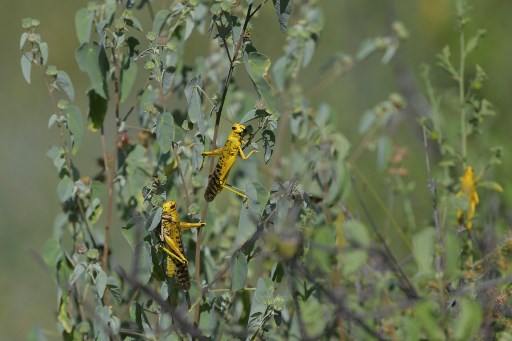
NAIROBI, Kenya (AFP) – Fran BLANDY
Billions of locusts swarming through East Africa are the result of extreme weather swings and could prove catastrophic for a region still reeling from drought and deadly floods, experts said Friday.
Dense clouds of the ravenous insects have spread from Ethiopia and Somalia into Kenya, in the region’s worse infestation in decades.
The UN’s Food and Agriculture Organization (FAO) estimated one swarm in Kenya at around 2,400 square kilometres (about 930 square miles) — an area almost the size of Moscow — meaning it could contain up to 200 billion locusts, each of which consume their own weight in food every day.
The locust invasion is the biggest in Ethiopia and Somalia in 25 years, and the biggest in Kenya in 70 years, according to the FAO.
If unchecked, locust numbers could grow 500 times by June, spreading to Uganda and South Sudan, becoming a plague that will devastate crops and pasture in a region which is already one of the poorest and most vulnerable in the world.
This could lead to “a major food security problem”, Guleid Artan from regional expert group the Climate Prediction and Applications Centre (ICPAC), told a press conference in Nairobi.
The locusts, he said, were the latest symptom of extreme conditions that saw 2019 start with a drought and end in one of the wettest rainy seasons in four decades in some parts — with floods killing hundreds across East Africa.
The FAO says the current invasion is known as an “upsurge” — when an entire region is affected — however if it gets worse and cannot be contained, over a year or more, it would become what is known as a “plague” of locusts.
There have been six major desert locust plagues in the 1900s, the last of which was in 1987-89. The last major upsurge was in 2003-05.

Not ‘the end of times’
Artan said the invasion had come after a year of extremes which included eight cyclones off East Africa, the most in a single year since 1976.
This was due to a warmer western Indian Ocean, a climate condition known as the Indian Ocean Dipole which has conversely led to severe drought in Australia that is experiencing its own extremes: bushfires, hail and dust storms.
“We know East Africa is one of the most vulnerable to climate change. We know this region will see more extremes,” he warned.
One expert at the press conference in Nairobi had to reassure attendees that the locust invasion following the drought and floods was not a portent of the biblical “end of times”.
The massive swarms entered Kenya in December and have torn through pastureland in the north and centre of the country.
While farmers were relatively lucky as their crops had already matured or been harvested by the time they arrived, herders face another heavy blow as vegetation for their animals is consumed by the voracious locusts.
Artan said the pastoralists were just emerging from three years of drought, and that recovery from a dry spell usually takes them up to five years.
And if the locusts are not brought under control by the start of the next planting and rainy season — typically around March — farmers could see their crops decimated.
As thick clouds of the insects descend on plants and blacken the sky, Kenyans have been seen shooting in the air, banging cans and racing around, waving sticks in desperation to shoo them away.
In eastern Meru, residents accused the government of not doing enough, complaining there were still swarms present despite aerial spraying being carried out.
“They told us that we will not see them again but there are still many of them spotted yesterday and today on trees and vegetation in the farm,” said Emmanuel Kubai, a resident of Igembe North where villagers were hurling stones to vegetation to scare them away.

‘Bodes ill for the region’
Stephen Njoka, director of the Desert Locust Control Organisation for Eastern Africa, which is based in Nairobi, said Kenya had five aircraft spraying pesticides on swarms, and four others conducting surveillance.
He said the chemicals did not pose a threat to humans and that authorities were doing their best to limit damage to other small insects, pollinators and pastureland.
Similar control operations are under way in Ethiopia and Somalia. However insecurity in Somalia was hampering some spraying operations, the FAO has said.
The species — desert locusts — are notoriously difficult to control as they often occur in remote areas and can move up to 150 kilometres (90 miles) in one day.
According to the regional Food Security and Nutrition Working Group, East Africa is already experiencing a high degree of food insecurity, with over 19 million people experiencing acute hunger.
Save the Children’s regional director for East and Southern Africa, Ian Vale, said in a statement Wednesday that the charity’s staff in Kenya were battling “swarms so thick they can barely see through them”.
“This new disaster bodes ill for the region in 2020… The erratic weather of 2019 and the decade prior has already severely eroded the capacity of families to bounce back from unexpected crises.”

© Agence France-Presse







